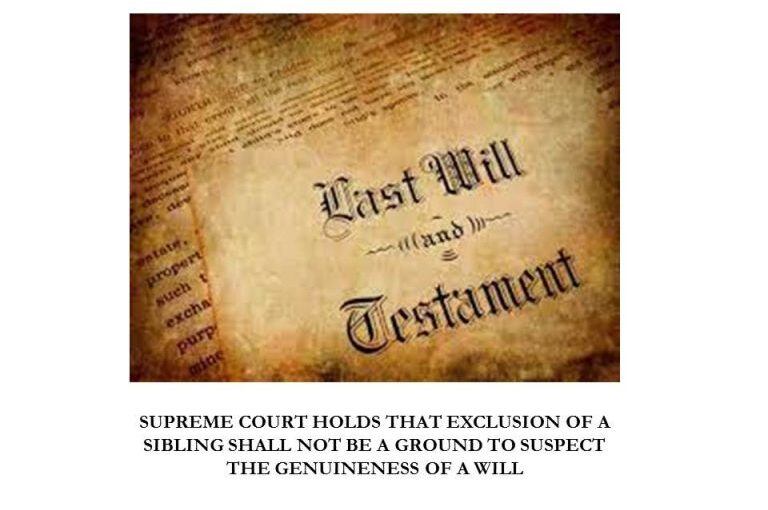SUPREME COURT HOLDS THAT EXCLUSION OF A SIBLING SHALL NOT BE A GROUND TO SUSPECT THE GENUINENESS OF A WILL
A Two Judge Bench of the Hon’ble #SupremeCourt of India comprising of Justices Sanjay Kishan Kaul, M.M. Sundresh passed a Judgment dated 07-10-2021 in the case of V. Prabhakara v. Basavaraj K. (Dead) By Lr. & Anr. Civil Appeal No.1376-1377 of 2010 and held that an #exclusion of a #sibling shall not be a ground to suspect the genuineness of a #Will.
In the present case, the Suit Property belonged to one Ms Jessie Jayalakshmi (Deceased).
On 04-09-1985, a Registered Will (Exhibit 4) was executed in favour of one V Prabhakara (Appellant), by the Deceased, who had adopted the Appellant as her son. The Appellant’s brother, Mr. Vijay Kumar attested the Will.
The relationship between the Deceased and her husband (Respondent No. 1) got strained. On 26-03-1988, the Deceased and her husband obtained a divorce decree however; the Respondent No. 1 was permitted to reside in the Suit Property. The Respondent No. 1 refused to vacate the Suit Property, which is a residential house. The Appellant paid all the statutory dues for the Suit Property; a suit for declaration and for possession was filed in O.S. No. 51 of 1992 which was decreed on 11-12-2003.
Before the Trial Court
The Defendants/Respondents acknowledged the factum of execution of Exhibit P4, however they introduced another Exhibit D1, (an unregistered Will), allegedly executed by the Deceased in favour of the Respondent No.2, the son of Respondent No. 1. It is their case that Exhibit P4 has been replaced by Exhibit D1. It was also their contention that D1 spoke about the mortgage between the Deceased and her husband upon payment of Rs. 31,000 in the Deceased’s favour.
On 11-12-2003, the Trial Court decreed the Suit after it was satisfied that requirements of Section 63 of the Indian Succession Act, 1925 r/w Section 68 of the Indian Evidence Act, 1872 were complied with in order to prove Exhibit P4. Further, the Trial Court gave exhaustive reasoning while doubting the genuineness of Exhibit D1.
Before the High Court
Aggrieved, the Respondents approached the High Court invoking Section 96 of the Civil Procedure Code in RFA No. 692 of 2004 which was decided on 20-09-2006. The High Court reaffirmed the findings of the Trial Court with respect to the genuineness of Exhibit D1. However, in the absence of any specific pleading the High Court observed that there is no logic in the exclusion of the Appellant and PW2.
Incidentally, it has been held that evidence of PW3 would not be sufficient.
The High Court affirmed the reasons for doubting the genuineness of Exhibit D1 and the High Court dismissed the Suit and allowed the Appeal.
It was observed by the High Court that the exclusion of the Appellant’s siblings from the Will was not based on sound logic and that evidence by attesting witness was not sufficient enough to remove the suspicion around Exhibit P4.
The Appellant had also filed an Application for review however; the same was dismissed by the High Court on 23-11-2007.
Aggrieved, the Appellant approached the Hon’ble Supreme Court of India.
Before the Supreme Court
After taking into consideration, the facts and circumstances of the case and arguments advanced by the parties to the dispute, the Apex Court held that “a testamentary court is not a court of suspicion but that of conscience. It has to consider the relevant materials instead of adopting an ethical reasoning. A mere exclusion of either brother or sister per se would not create a suspicion unless it is surrounded by other circumstances creating an inference. In a case where a testatrix is accompanied by the sister of the beneficiary of the Will and the said document is attested by the brother, there is no room for any suspicion when both of them have not raised any issue.”
Furthermore, the Bench noted that the Appellant complied with the conditions laid down under Section 63 of the Indian Succession Act, 1925 and Section 68 of the Indian Evidence Act, 1872 and the Appellant’s siblings who were present at the time of the execution of the registered Will did not raise any demur.
In this regard the Court made the following observation:
Both the Courts found that Exhibit D1 is a forged and fabricated document. The Appellate Court, in our considered view, has unnecessarily created a suspicion when there is none. The Respondents have not denied the factum of the execution of Exhibit P4. The very fact that they made reliance upon Exhibit D1, which took note of Exhibit P4 as validly done, there is no need for any suspicion on the part of the High Court. That too, when the Trial Court did not find any. Such a suspicion, as stated earlier, did not arise from either of the siblings of the Appellant who would otherwise be entitled to a share in the Suit Property. Their exclusion will not ensure to the benefit of the Defendants who are bound by the recitals under Exhibit D1 and averments made in their written statement.
Thus, the Apex Court while allowing the Appeal and restoring the Judgment and Decree of the Trial Court in O.S. No. 51 of 1992, held that the Judgment and Decree of the Appellate Court is to be set aside.
Harini Daliparthy
Senior Associate
The Indian Lawyer & Allied Services
Edited by
Sushila Ram Varma
Chief Consultant and Editor
The Indian Lawyer & Allied Services





































Leave a Reply